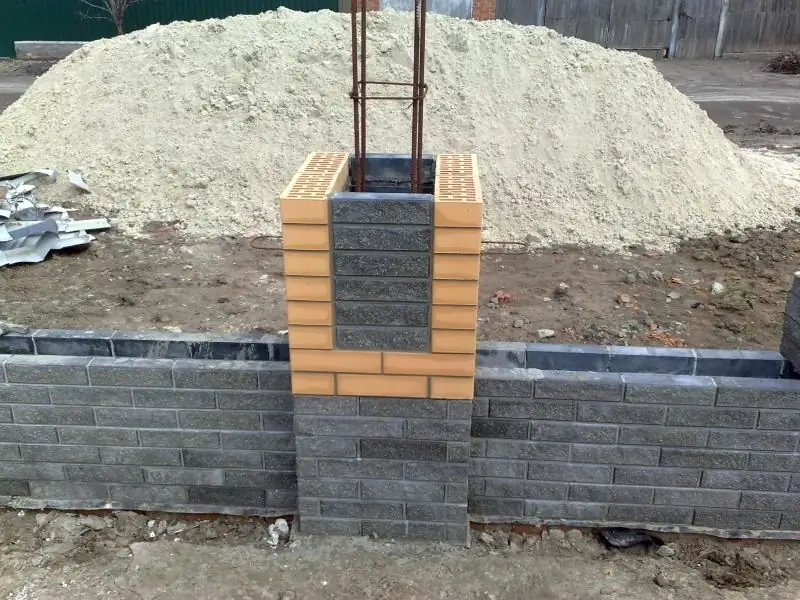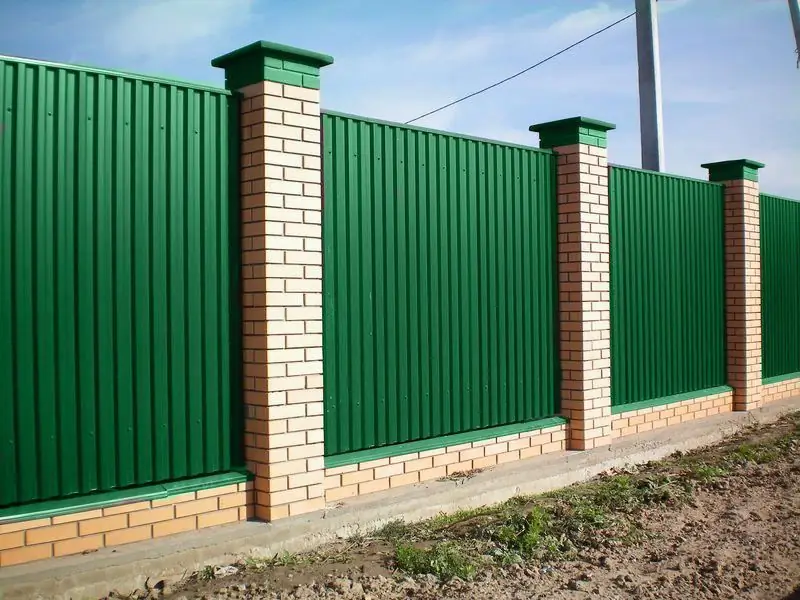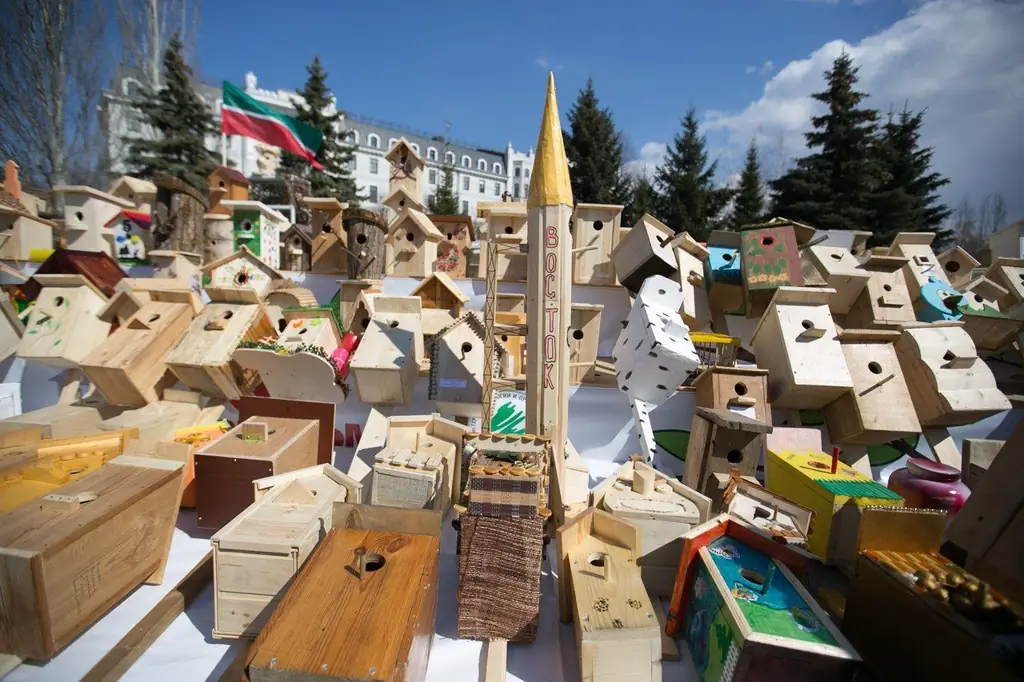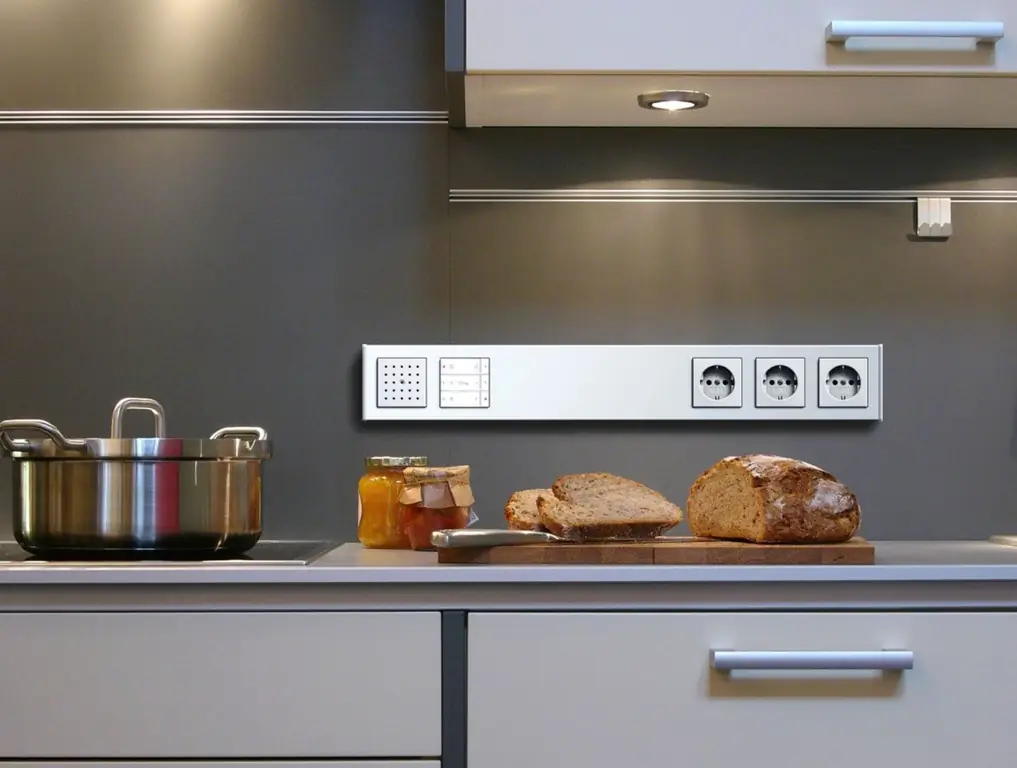
Table of contents:
- The original fence from the mesh-netting for the summer cottage
- What is a chain-link mesh
- Advantages and disadvantages of a chain-link mesh for building a fence
- Fence mesh types
- Preparation for the construction of a fence, calculation of the area
- Step-by-step instructions for making a fence with your own hands
- Decorating and decorating
- Video: Installing a mesh-netting at a summer cottage
- Author Bailey Albertson [email protected].
- Public 2023-12-17 12:53.
- Last modified 2025-06-01 07:32.
The original fence from the mesh-netting for the summer cottage

In order to protect their possessions in a summer cottage or in the private sector, they use a fence. The construction of such a structure requires additional investment of money and time. In order to save money, you can make a fence with your own hands. For this, a fence made of a chain-link mesh is the best fit.
Content
- 1 What is a mesh-netting
- 2 Advantages and disadvantages of a chain-link mesh for building a fence
-
3 Types of mesh for a fence
- 3.1 Non-galvanized
- 3.2 Galvanized
- 3.3 Plasticized
-
4 Preparing for the construction of a fence, calculating the area
- 4.1 What material to choose. Advice
- 4.2 Calculation of the required quantity
- 4.3 Calculation of materials for a fence from sections
- 4.4 Tools and materials for work
-
5 Step-by-step instructions for making a fence with your own hands
- 5.1 Area markings
- 5.2 Setting the posts
- 5.3 Installing the mesh
- 5.4 Manufacturing a sectional fence
-
6 Decorating and decorating
6.1 Closing ourselves from neighbors' eyes
- 7 Video: Installing a mesh-netting at a summer cottage
What is a chain-link mesh
This mesh was invented in the 19th century by the German bricklayer Karl Rabitz. It was originally used to facilitate plastering of walls. Over time, she found application in many industries, ranging from the construction of barriers or cages for animals and birds, and ending with the construction of support for mine workings in mines.
Low-carbon steel wire and its other types are used in the manufacture: stainless, aluminum, galvanized or coated with polymers. To obtain a netting, a special simple machine is used, which twists a wire spiral into each other, and winds the finished product into rolls.
Advantages and disadvantages of a chain-link mesh for building a fence
Benefits:
- It allows air and sunlight to pass through, so it does not interfere with the cultivation of cultivated plants.
- Fast and uncomplicated installation, accessible to every person who is in the slightest degree familiar with hand-held construction tools.
- Since the structure of the fence is light, a reinforced foundation is not required for it.
- A chain-link fence does not need any special care.
- Strong, reliable, inexpensive and durable material.
Disadvantages:
- A chain-link fence will not hide your plot or house from prying eyes, but this problem can also be solved by decorating the fence with plants.
- Does not provide sound insulation.
- A fence made of non-galvanized mesh quickly rusts.
Fence mesh types
Non-galvanized

Non-galvanized wire mesh
Such a mesh is made of "black" wire, unprotected from corrosion. It is the cheapest option from all other types and requires additional processing to ensure the durability of the structure. It is used as a temporary barrier and needs painting to increase its service life. The service life of an unpainted canvas is 2-3 years, but if the ungalvanized mesh is covered with paint, this will increase the service life up to 10 years.
Galvanized

Galvanized mesh
This type of mesh is also made from low carbon steel, but has a protective layer in the form of a zinc coating. Thanks to this, the galvanized mesh is protected from rust and will serve for many years without additional processing and maintenance.
Plasticized

Plasticized mesh
If a polymer is used as a protective layer, then such a chain-link mesh is called plasticized. Since dyes are used in its manufacture, it exists in different color shades and looks much more attractive than its relatives. This type of material does not need additional processing and is not afraid of various weather conditions, and a wide range of colors will provide design solutions when building a fence.
Preparation for the construction of a fence, calculation of the area
In order to calculate the area for the fence, you first need to know the perimeter of the site. For example, let's take a plot of 10 acres in the shape of a square. Since the length of the square is equal to the width (a) and has right angles, the perimeter is calculated by the formula P = 4 x a. Since the area of the site is known (1000 m 2), and the formula for the area of the square is S = a 2, then a = 31.63 m, so the perimeter P = 126.52 m. Now you can easily calculate how many materials you need. For example, the netting is sold in rolls of 10 m, so it will need 12 whole rolls plus a 6.5 m section.
What material to choose. Advice
The chain-link mesh also differs in the size and shape of the cells, which are in the form of a rectangle, rhombus, square or other geometric figure. When building a fence, the shape of the cells does not affect the result of the work in any way, and its dimensions have some significance. It is important to remember that the smaller the cell size, the stronger the canvas, but such a mesh does not transmit light well. The large segment size also has disadvantages as it will not provide adequate protection against small animals and poultry. To build a fence, a mesh with mesh sizes from 40 to 50 mm is used. This version of the canvas will protect the area from unwanted penetration and let in a sufficient amount of light for the plants.
The height of the web and the thickness of the wire from which it is made are also of great importance. As for the height, it starts from 1.5 m and reaches 3 m. The optimal height of the fence for the fence is 1.5 m, and the best fit is a mesh with a wire thickness of 2-2.5 mm.
If the thickness is greater, then this will lead to some difficulties. Firstly, the canvas will cost more, and secondly, this will affect the choice of material for the support posts, since the weight of the mesh will increase and the installation will become more difficult.
Calculation of the required amount
The netting netting is realized in rolls, the standard length of which is 10 m. To prevent it from drooping, supports are installed along the fence line every 2-2.5 m. Therefore, 5 posts will be needed for one roll. The part of the support that is above the ground after installation must be 10 cm higher than the width of the net. The columns themselves need to be buried in the ground one third of their height.
Based on this, we can calculate how many posts and how long the mesh we need. For example, we are building a fence 30 m long, whose height should be 1.5 m. This will require 3 rolls of mesh and 16 supports, the length of which will be in the range of 2.3-2.5 m. In addition, each support is installed three hooks for fasteners (top, bottom and middle) total 48 pcs. You will also need a steel bar or reinforcement with a thickness of 5 mm in order to stretch the mesh. Since it will run at the top and bottom of the grid, it will take 60 m in total.
To calculate the required amount of concrete for pouring one hole with a support post, you need to find out its volume and subtract the volume of that part of the post that is buried in the ground. Since the holes and columns are cylindrical, we make calculations using the formula:
V = ∏R2 * H
- The number ∏ = 3.14.
- R is the radius of the cylinder (hole) in meters.
- H - cylinder height (hole depth) in meters.
The hole diameter is 12 cm (0.12 m) and the radius is 0.12 / 2 = 0.06 m. Depth (H) is 80 cm or 0.8 m.
We substitute the data into the formula:
V = 3.14 * 0.06 * 2 * 0.8 = 0.30144 m 3 (hole volume)
For the posts we will use metal pipes with a diameter of 80 mm. The radius (R) of such a column is 40 mm or 0.04 m. The height (H) is the same as the depth of the hole - 0.8 m.
We use the same formula:
V = 3.14 * 0.04 * 2 * 0.8 = 0.20096 m 3 (volume of the poured part of the support)
Now we find out how much solution is needed in order to install one column in the hole:
0.30144-0.20096 = 0.10048 m 3
Accordingly, for 16 holes you will need: 0.10048 * 16 = 1.60768 m 3 of concrete.
We prepare the batch based on the proportions: 1 part of cement (M 400), 2 parts of sand, 4 parts of crushed stone. Water is added until the mixture reaches a sour cream state.
To get 1.6 m 3 of concrete you will need:
- Cement (M 400) - 480 kg.
- Crushed stone - 1920 kg.
- Sand - 960 kg.
Calculation of materials for a fence from sections
In the event that the construction of the fence is carried out in a sectional manner, then you also need to calculate the number of metal corners for each frame in which the mesh is attached. It is better to use a metal corner 40 by 40 mm, with a wall thickness of 5 mm. We calculate its amount per section: the height of the frame is the same as the height of the grid (1.5 m), and the distance between the posts is 2-2.5 m.
Having made simple calculations, we see that each section will need 8 m of a metal corner. There are 16 sections in total, so the total length of the corner is 128 m. The mesh is fastened to the frame of the corners using 5-7 mm reinforcement, for such a fence it will take 128 m. To install the finished sections, use metal plates 5 x 15 cm in size and 5 mm, 4 pcs. for internal posts and 2 pcs. at the extreme, total - 60 pcs.
Tools and materials for work
- hand drill or shovel;
- tape measure, building level;
- metal primer;
- paint;
- metal hooks;
- Rabitz;
- metal pipe with a diameter of 60 to 80 mm;
- sandpaper;
- Bulgarian;
- welding machine;
- metal corner 40 × 40 mm;
- sand, crushed stone and cement for mortar;
- metal plates (5 × 15 cm, thickness - 5 mm).
Step-by-step instructions for making a fence with your own hands
Area marking
We clean the place for the construction of the fence from debris, plants and other possible obstacles. We determine the points where the pillars will be located and start marking the territory. To do this, you need to hammer the pegs into the extreme places of the fence and pull a nylon cord between them.

Pulling on the cord
You need to pull the cord so that it does not sag or dangle from the wind. Make sure that the taut thread does not catch on possible obstacles. Consider the cross-section of the support pillars, taking into account the fact that they will be located inside the site, and the mesh from the side of the street or neighboring territory.
The stretched nylon cord acts as a beacon not only during the marking of the area, but also throughout the construction. It will provide linearity and control of the fence height around the perimeter. After that, we mark out the places for the intermediate pillars, the distance between them should be within 2.5-3 m.
Installation of posts
After all the materials, tools are prepared and the area is marked, they begin to install the pillars. According to pre-made marks, with the help of a shovel or a drill, holes are made with a depth of 80 to 120 cm. The softer the soil, the deeper the holes should be and vice versa.

Drilling holes with a drill
Since we will use metal pipes as pillars, they must be cleaned of rust and oil deposits before installation, and then sanded with sandpaper. Using a welding machine, weld the hooks for attaching the mesh, clean the welding places with a grinder and prime the entire surface of the post with an anti-corrosion primer.

Aligning the Support Pillars with a Level
Next, we install the supports in the pits, level them and fix them in this position with spacers. Make sure all posts are at the same height and in a straight line. If this is not the case, then by adjusting the depth and width of the holes, achieve the desired result. After that, you can safely pour concrete mortar into the pits. It is recommended to start installing the mesh no earlier than 48 hours after the concrete mixture has completely solidified.
Mesh installation

Attaching the net to prepared hooks
For installation, do not completely unwind the net, it will be much more convenient to attach a whole roll to the corner post in a vertical position and hook the edges of the net to the prepared hooks.

Welding steel bars
Next, we unwind the roll, stretch the mesh well and attach it in the same way to the adjacent post. The work is best done with a partner: one can pull the canvas, and the other can fasten it with hooks. Follow this procedure around the entire perimeter of the fence. To prevent the mesh from sagging over time, thread a steel bar or reinforcement into the upper cells at a distance of 5-7 cm from the edge along the entire length of the fence and weld it to each post. Do the same from the bottom, just step back from the bottom edge of the net by 20 cm.
Sectional fence manufacturing
Mark the area and install the pillars in the same way as in the previous case, only instead of hooks, metal plates are welded onto the pillars, retreating from the upper and lower edges by 20 cm. To make a section, you need to measure the distance between adjacent supports and subtract 15-20 from it cm, so we know the width of the frame. The height will be the same as the width of the mesh minus 20 cm. Next, cut the blanks from the corner of the required length and weld a rectangle from them. With the help of a grinder, they clean the welding places and grind the inner and outer sides of the frame with an emery cloth.

Making a frame for a mesh
After that, the roll is unwound and the required length of the mesh is cut off with a grinder (the distance between the supports is minus 15 cm). Further, along the entire perimeter of the cut sheet, reinforcement with a thickness of 5-7 mm is threaded into the extreme cells.
The welded frame is placed on a flat surface with the inner side up and a prepared mesh with reinforcement is placed in it, then the upper rod is welded to the upper corner of the frame. Next, the lower side is pulled and the fittings are fixed to the corner by welding. The sides are installed in the same way.

Pulling the netting of the chain-link onto a metal frame
After that, the finished section is placed between the supports and attached to the previously prepared metal plates by welding.

Installation diagram of a fence from sections
When further installing the remaining sections, pay attention to the edges of the adjacent frames, they should be on the same level. For convenience, use a level or taut cord. After installation is complete, all frames must be primed and painted.
Decorating and decorating
In most cases, a chain-link fence is not decorated, but left as it is. If you decide to build an original structure, then there is no limit to your imagination in this matter. Here are some options for how you can decorate your fence.
-
You can use CDs for decoration. First they are painted, and then they are attached to the mesh with a thin wire.

Fence decoration Decorating CDs
-
If the cells are small, then bottle caps are used for decoration. The fastening method remains the same as in the previous version.

Fence decoration from mesh Decorating with plastic bottle caps
-
What is not a material for decoration masking tape.

Fence decor Decorating the fence with masking tape
-
If you decorate the fence with colored glass or plastic squares, then it will look very beautiful and original.

Fence decoration Decorating a mesh fence with glass or plastic squares
-
You can also decorate your fence with colored thread embroidery on the mesh cells.

Fence decoration Embroidery with threads on a netting
- Colored patches or bags for cross stitching will help to add originality. To do this, find a suitable picture in a magazine or on the Internet with a ready-made scheme of work, set it in front of you and repeat the drawing in cells in accordance with the original.

Cross-stitch embroidery on a netting

Finished work
We close ourselves from neighbors' eyes
The disadvantage of a chain-link fence is that it does not cover the area from prying eyes. Some more efforts are needed to correct these omissions.
One way to close a fence is with a hedge. Climbing plants are most commonly used, but it may take several years for them to fill all sections. Planting annual plants, such as morning glory, may be a way out. During the season, it will cover not only the fence mesh, but also the nearby trees and bushes. The disadvantage of such a barrier is that it will only serve until the fall.

What is natural is not ugly: plants will decorate your fence better than any craft
Another way to make your fence opaque is to use fake needles. Since it is realized in the form of coils of wire, it will be enough just to thread it between the cells.

Closing the fence with artificial needles
A very original method of closing the fence is reed. As in the previous case, it must be threaded vertically through the mesh of the chain-link.

Reed - an original solution for decorating and hiding the site
To keep the fence closed and look more modern, polycarbonate is often used. It comes in a variety of transparency and color shades. Attached directly to the fence posts with self-tapping screws.

Behind the polycarbonate you will hardly be seen by prying eyes
Video: Installing a mesh-netting at a summer cottage
As you can see, making a fence from a chain-link mesh is not so difficult. Like other similar structures, it has advantages and disadvantages. It is important to remember that this is a budget option, which is often erected as a temporary option for a fence. Although, as practice shows, if the installation is done correctly, then it will last for many years. In addition, if you show imagination and creativity, such a fence will delight its owner not only with practicality, but also with an aesthetic, original look.
Recommended:
How To Install Fence Posts With Your Own Hands, Including Without Concreting, At The Correct Distance And Depth - Instructions With Photos And Videos

How to install fence posts: installation methods, use of suitable materials
DIY Fence Made Of Corrugated Board, Installation Of A Fence Made Of Corrugated Board

A fence made of corrugated board with your own hands on a personal plot. Step by step instructions on how to install a fence made of corrugated board with two types of pillars
How To Clean The Hood In The Kitchen From Fat, As Well As The Mesh And Its Other Parts, Using Various Methods And Means

We clean the hood in the kitchen and its other parts from grease and dirt: what tools and methods to use, especially for different materials, what is prohibited
How To Make A Birdhouse Out Of Wood With Your Own Hands: Options With Drawings And Diagrams + Photos And Videos

How to make a wooden birdhouse with your own hands. The right tree, the necessary materials and tools, drawings, step-by-step manufacturing instructions. Video
The Location Of The Sockets In The Kitchen: Placement Height, How Many And Where Needed, Photos, Diagrams

Rules and regulations for the location of outlets in the kitchen. Calculation of the required number of outlets. Drawing up an electrical wiring diagram. Types and installation of sockets
